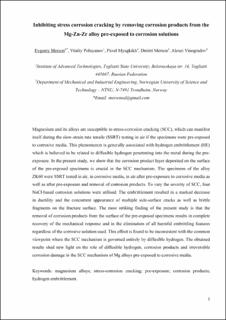| dc.contributor.author | Merson, Evgeniy | |
| dc.contributor.author | Poluyanov, Vitaliy | |
| dc.contributor.author | Myagkikh, Pavel | |
| dc.contributor.author | Merson, Dmitry | |
| dc.contributor.author | Vinogradov, Alexey | |
| dc.date.accessioned | 2022-07-05T07:09:57Z | |
| dc.date.available | 2022-07-05T07:09:57Z | |
| dc.date.created | 2021-04-19T16:30:57Z | |
| dc.date.issued | 2021 | |
| dc.identifier.citation | Acta Materialia. 2021, 205 1-15. | en_US |
| dc.identifier.issn | 1359-6454 | |
| dc.identifier.uri | https://hdl.handle.net/11250/3002652 | |
| dc.description.abstract | Magnesium and its alloys are susceptible to stress-corrosion cracking (SCC), which can manifest itself during the slow-strain rate tensile (SSRT) testing in air if the specimens were pre-exposed to corrosive media. This phenomenon is generally associated with hydrogen embrittlement (HE) which is believed to be related to diffusible hydrogen penetrating into the metal during the pre-exposure. In the present study, we show that the corrosion product layer deposited on the surface of the pre-exposed specimens is crucial in the SCC mechanism. The specimens of the alloy ZK60 were SSRT tested in air, in corrosive media, in air after pre-exposure to corrosive media as well as after pre-exposure and removal of corrosion products. To vary the severity of SCC, four NaCl-based corrosion solutions were utilised. The embrittlement resulted in a marked decrease in ductility and the concurrent appearance of multiple side-surface cracks as well as brittle fragments on the fracture surface. The most striking finding of the present study is that the removal of corrosion products from the surface of the pre-exposed specimens results in complete recovery of the mechanical response and in the elimination of all harmful embrittling features regardless of the corrosive solution used. This effect is found to be inconsistent with the common viewpoint where the SCC mechanism is governed entirely by diffusible hydrogen. The obtained results shed new light on the role of diffusible hydrogen, corrosion products and irreversible corrosion damage in the SCC mechanism of Mg alloys pre-exposed to corrosive media. | en_US |
| dc.language.iso | eng | en_US |
| dc.publisher | Elsevier | en_US |
| dc.rights | Attribution-NonCommercial-NoDerivatives 4.0 Internasjonal | * |
| dc.rights.uri | http://creativecommons.org/licenses/by-nc-nd/4.0/deed.no | * |
| dc.title | Inhibiting stress corrosion cracking by removing corrosion products from the Mg-Zn-Zr alloy pre-exposed to corrosion solutions | en_US |
| dc.type | Peer reviewed | en_US |
| dc.type | Journal article | en_US |
| dc.description.version | acceptedVersion | en_US |
| dc.rights.holder | This is the authors' accepted manuscript to an article published by Elsevier. Locked until 17.12.2022 | en_US |
| dc.source.pagenumber | 1-15 | en_US |
| dc.source.volume | 205 | en_US |
| dc.source.journal | Acta Materialia | en_US |
| dc.identifier.doi | 10.1016/j.actamat.2020.116570 | |
| dc.identifier.cristin | 1905142 | |
| cristin.ispublished | true | |
| cristin.fulltext | postprint | |
| cristin.qualitycode | 2 | |

